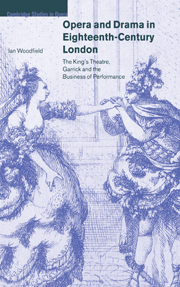 Opera and Drama in Eighteenth-Century London
Opera and Drama in Eighteenth-Century London Published online by Cambridge University Press: 22 September 2009
Probably no quality was more necessary for an opera impresario than the ability to cope with a crisis. Between 1774 and 1776, Brooke had to contend with a whole series of interlocking problems involving the irreconcilable demands of her leading singers, litigation over a broken contract and competition from a rival promoter of Italian opera stars. These were just the kinds of difficulties that had engulfed Hobart in 1771. The forceful and clear-sighted manner with which she surmounted the problems amounts to an impressive example of crisis management.
The new season began with Sacchini's Lucio vero, and on 29 January Perseo received its première. Both were successful, receiving sixteen and seventeen performances respectively. A reviewer in the Public Advertiser thought the music of Perseo up to Sacchini's usual standard, having ‘all the fire, all the elegance, all the pathos of that celebrated composer’. The choruses were still attracting favourable comment, being deemed ‘pleasing’ and one in particular ‘beautifully pathetic’. High-profile theatrical spectacle, prominent in Sacchini's first London operas, is still much in evidence. A lavish production meant lavish expenditure, and whatever his own inclinations, the composer could not have taken this course without the support of the opera management. Reviewers had remarked on the studied magnificence of the costumes and the elegance of the scenery in Il Cid, and Burney later praised the ‘knowledge of stage effects’ shown in this opera and in Tamerlano.
To save this book to your Kindle, first ensure [email protected] is added to your Approved Personal Document E-mail List under your Personal Document Settings on the Manage Your Content and Devices page of your Amazon account. Then enter the ‘name’ part of your Kindle email address below. Find out more about saving to your Kindle.
Note you can select to save to either the @free.kindle.com or @kindle.com variations. ‘@free.kindle.com’ emails are free but can only be saved to your device when it is connected to wi-fi. ‘@kindle.com’ emails can be delivered even when you are not connected to wi-fi, but note that service fees apply.
Find out more about the Kindle Personal Document Service.
To save content items to your account, please confirm that you agree to abide by our usage policies. If this is the first time you use this feature, you will be asked to authorise Cambridge Core to connect with your account. Find out more about saving content to Dropbox.
To save content items to your account, please confirm that you agree to abide by our usage policies. If this is the first time you use this feature, you will be asked to authorise Cambridge Core to connect with your account. Find out more about saving content to Google Drive.